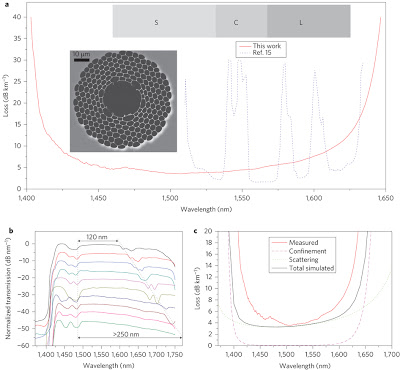Researchers at the University of Southampton in England have produced optical fibers that can transfer data at 99.7% of the universe’s speed limit: The speed of light. The researchers have used these new optical fibers to transfer data at 73.7 terabits per second — roughly 10 terabytes per second, and some 1,000 times faster than today’s state-of-the-art 40-gigabit fiber optic links, and at much lower latency.
The researchers overcame issues with vacuum transmission by fundamentally improving the hollow core design, using an ultra-thin photonic-bandgap rim. This new design enables low loss (3.5 dB/km), wide bandwidth (160nm), and latency that blows the doors off normal optic fiber — light, and thus the data, really is travelling 31% faster down this new hollow fiber. To achieve the transmission rate of 73.7 terabits per second, the researchers used wave division multiplexing (WDM) to transmit 37 40-gigabit signals down the hollow fiber. As far as we’re aware, this is one of the fastest ever transmission rates in the lab.
As for real-world applications, loss of 3.5 dB/km is okay, but it won’t be replacing normal glass fiber any time soon. For short stretches, though, such as in data centers and supercomputer interconnects, these speed-of-light fibers could provide a very significant speed and latency boost.
This will be rapidly adopted because the lower latency will be very valuable for computerized financial trading. It will also go into supercomputer data centers and cloud computer centers.
Nature Photonics – Towards high-capacity fibre-optic communications at the speed of light in vacuum
Wide-bandwidth signal transmission with low latency is emerging as a key requirement in a number of applications, including the development of future exaflop-scale supercomputers, financial algorithmic trading and cloud computing. Optical fibres provide unsurpassed transmission bandwidth, but light propagates 31% slower in a silica glass fibre than in vacuum, thus compromising latency. Air guidance in hollow-core fibres can reduce fibre latency very significantly. However, state-of-the-art technology cannot achieve the combined values of loss, bandwidth and mode-coupling characteristics required for high-capacity data transmission. Here, we report a fundamentally improved hollow-core photonic-bandgap fibre that provides a record combination of low loss (3.5 dB km−1) and wide bandwidth (160 nm), and use it to transmit 37 × 40 Gbit s−1 channels at a 1.54 µs km−1 faster speed than in a conventional fibre. This represents the first experimental demonstration of fibre-based wavelength division multiplexed data transmission at close to (99.7%) the speed of light in vacuum.
If you liked this article, please give it a quick review on ycombinator or StumbleUpon. Thanks

Brian Wang is a Futurist Thought Leader and a popular Science blogger with 1 million readers per month. His blog Nextbigfuture.com is ranked #1 Science News Blog. It covers many disruptive technology and trends including Space, Robotics, Artificial Intelligence, Medicine, Anti-aging Biotechnology, and Nanotechnology.
Known for identifying cutting edge technologies, he is currently a Co-Founder of a startup and fundraiser for high potential early-stage companies. He is the Head of Research for Allocations for deep technology investments and an Angel Investor at Space Angels.
A frequent speaker at corporations, he has been a TEDx speaker, a Singularity University speaker and guest at numerous interviews for radio and podcasts. He is open to public speaking and advising engagements.


